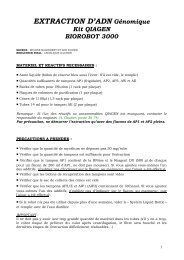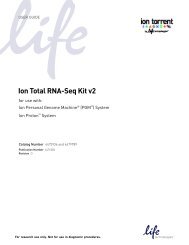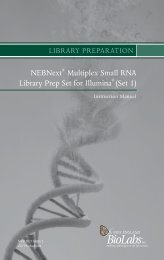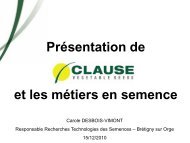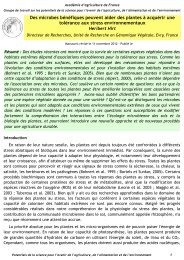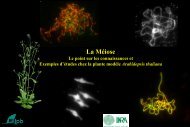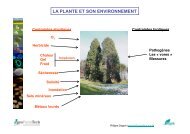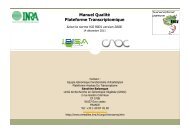The BLASTER suite Documentation - URGI
The BLASTER suite Documentation - URGI
The BLASTER suite Documentation - URGI
Create successful ePaper yourself
Turn your PDF publications into a flip-book with our unique Google optimized e-Paper software.
<strong>The</strong> <strong>BLASTER</strong> <strong>suite</strong> <strong>Documentation</strong><br />
Hadi Quesneville<br />
Bioinformatics and genomics<br />
Institut Jacques Monod, Paris, France<br />
http://www.ijm.fr/ijm/recherche/equipes/Bioinformatique-genomique<br />
Last modification: 05/09/06
<strong>The</strong> <strong>BLASTER</strong> programs <strong>suite</strong> are C++ programs developed for transposable element search<br />
and their annotation in large eukaryotic genome sequence. But we think that the tools are generic<br />
enough to be used in other contexts.<br />
<strong>The</strong> <strong>suite</strong> is composed by three programs <strong>BLASTER</strong>, MATCHER and GROUPER. <strong>The</strong> results of<br />
<strong>BLASTER</strong> can be treated further by the MATCHER and GROUPER program, but these two last programs<br />
can be also used in conjunction with other programs such as RepeatMasker, CENSOR, BLAST, BLAT, ...<br />
if their outputs are correctly formated as a <strong>BLASTER</strong> output file (i.e. *.align).<br />
<strong>BLASTER</strong><br />
<strong>BLASTER</strong> compares two sets of sequences: a query databank against a subject databank. For<br />
each sequence in the query databank, <strong>BLASTER</strong> launches one of the BLAST programs (blastn, tblastn,<br />
blastx, tblastx, blastp, megablast) (Altschul et al., 1990, 1997) to search the subject databank.<br />
<strong>BLASTER</strong> can use either WUBLAST or NCBIBLAST programs. It cuts long sequences before launching<br />
BLAST and reassembles the results afterwards. Hence, it can work on whole genomes, in particular to<br />
compare a genome with itself to detect repeats. <strong>The</strong> results of <strong>BLASTER</strong> can then be treated by the<br />
MATCHER and GROUPER programs described below.<br />
Commands<br />
usage: blaster [option]<br />
Options are:<br />
-q:<br />
query bank name, default=<br />
-s:<br />
subject bank name, default=<br />
-a:<br />
all_by_all, default=FALSE<br />
-W:<br />
use WU-BLAST, default=NCBI-BLAST<br />
-n:<br />
blast name, default=blastn<br />
-p:<br />
blast options, default=<br />
-l:<br />
fragment cutter length, default=50000<br />
-o:<br />
fragment cutter overlap, default=100<br />
-w:<br />
minimum cutter word, default=11<br />
-e:<br />
extention of cutted file, default=_cut<br />
-S:<br />
sensitivity, default=0 (3 levels for blastn, 3 being the most<br />
sensitive)<br />
-E:<br />
e-value filter, default=1e-10<br />
-I:<br />
identity filter, default=0<br />
-L:<br />
length filter, default=20<br />
-b:<br />
output filename prefix, default=<br />
-B:<br />
output filename prefix (no time stamp), default=<br />
-r:<br />
force re-run all, default=Off<br />
-P:
only prepare the data default=Off<br />
Outputs:<br />
Several files are produced by <strong>BLASTER</strong>.<br />
*_cut : preprocessed file for use with blast (cut in chunk and remove N stretches)<br />
*_cut.nhr, *_cut.nin, *_cut.nsq, ... : bank preprocessed by the NCBI blast formatdb<br />
program<br />
*_cut.xnd, *_cut.xns, *_cut.xnt, ... : bank preprocessed by the WU blast xdformat<br />
program<br />
*.Nstretch.map : coordinates of the removed N stretches<br />
*.param : dump of the used parameters<br />
*.raw : raw BLAST results<br />
*.seq_treated: sequences treated by <strong>BLASTER</strong>. Used to restart in case of failure.<br />
last_time_stamp.log: a file containing the last_time stamp number used.<br />
*.align : results of <strong>BLASTER</strong> in a tabular format. Columns are separated by tabulations<br />
col1: query sequence name<br />
col2: match start coordinate on the query sequence<br />
col3: match end coordinate on the query sequence<br />
col4: subject sequence name<br />
col5: match start coordinate on the subject sequence<br />
col6: match end coordinate on the subject sequence<br />
col7: BLAST Evalue<br />
col8: BLAST score<br />
col9: identity percentage<br />
MATCHER<br />
MATCHER has been developed to treat <strong>BLASTER</strong> results and to map the matches (HSPs) of the<br />
subject sequences on the queries. But it can be used in conjunction with other programs such as<br />
RepeatMasker or Censor.<br />
Cross hits are filtered as overlapping hits. Here, overlapping means also included. So when two<br />
HSPs overlap on the genomic sequence, the one with the best alignment score is kept, the other is<br />
truncated such as nonoverlapping region remains on the HSP. As a result of this procedure an HSPs is<br />
totally removed only if it is included in a longer one with a best score. By this way, nested elements are<br />
kept.<br />
Long insertions (or deletions) in one of two homologous sequences result in two HSPs, instead<br />
of one with a long gap. Thus the remaining HSP are linked by dynamic programming as in FASTA<br />
algorithm. A score is calculated by summing HSP scores and substracting a gap penalty (x times the gap<br />
length) and a mismatch penalty (x times the mismatch length region).<br />
<strong>The</strong> algorithm is inspired by the first part of the algorithm of sim2 described in Chao et al.<br />
(1995) CABIOS, Vol. 11, pages 147153. But it is modified to make local alignment as follows.
Commands<br />
1) An HSP is chained with a chain of others only if its score is less than the score of<br />
the resulting chain that links it. Thus, the chaining is stopped if the score of the<br />
resulting chain of HSP is less than the HSP not chained. <strong>The</strong> best scoring chain is<br />
kept.<br />
2) <strong>The</strong>n to identify other HSP chains, the chain previously found is removed, and we<br />
search again for the next best HSP chain. This is done iteratively until no chain is<br />
found.<br />
3) This algorithm is repeated independently for HSP matching in strand +/+, ±, and <br />
/+<br />
A maximum of x% of overlap between the HSP is authorized.<br />
usage: matcher [option]<br />
Options are:<br />
-m:<br />
matches text file (in <strong>BLASTER</strong> *.align format)<br />
-q:<br />
query bank name, default=<br />
-s:<br />
subject bank name, default=<br />
-j:<br />
join matches, default=false<br />
-i:<br />
identity tolerance to join matches, default=2<br />
-g:<br />
gap penalty to join matches, default=0.05<br />
-d:<br />
distance penalty to join matches, default=0.2<br />
-c:<br />
authorized overlap to join matches, default=20<br />
-E:<br />
e-value filter, default=1e-10<br />
-I:<br />
identity filter, default=0<br />
-L:<br />
length filter, default=20<br />
-b:<br />
output filename prefix, default=<br />
-B:<br />
output filename prefix (no time stamp), default=<br />
-a,<br />
all conflicting subject default=FALSE<br />
Outputs<br />
*.clean_match.fa : sequences of the matching region. This is a concatenation of the joined<br />
fragments<br />
*.clean_match.map : coordinates of the whole matching region (boundaries of the joined<br />
fragments) on the query in the following tabulated format (the separator is a tabulation):<br />
col1: the subject sequence name<br />
col2: the query sequence name<br />
col3: start coordinate<br />
col4: end coordinate
*.clean_match.param : dump of the used parameters for MATCHER<br />
*.clean_match.path : results of MATCHER in a tabular format. Columns are separated by<br />
tabulations.<br />
col1: path number. Joined fragments have the same path number<br />
col2: query sequence name<br />
col3: match start coordinate on the query sequence<br />
col4: match end coordinate on the query sequence<br />
col5: subject sequence name<br />
col6: match start coordinate on the subject sequence<br />
col7: match end coordinate on the subject sequence<br />
col8: BLAST Evalue<br />
col9: BLAST score<br />
col10: identity percentage<br />
*.clean_match.tab : summary results of MATCHER in a tabular format. One line per joined<br />
fragment. Columns are separated by tabulations.<br />
col1: query sequence name<br />
col2: whole match start coordinate on the query sequence<br />
col3: whole match end coordinate on the query sequence<br />
col4: length on the query sequence<br />
col5: length in percentage of the query sequence<br />
col6: length on the query relative to the subject length in percentage<br />
col7: subject sequence name<br />
col8: whole match start coordinate on the subject sequence<br />
col9: whole match end coordinate on the subject sequence<br />
col10: BLAST Evalue<br />
col11: BLAST score<br />
col12: identity percentage<br />
col13: path number<br />
GROUPER<br />
GROUPER has been developed to treat <strong>BLASTER</strong> results. It uses HSPs to gather similar<br />
sequences into groups by simple link clustering. An alignment belongs to a group if one of the two<br />
aligned sequences already belongs to this group over 95% of its length. Groups that share sequence<br />
locations are regrouped into what we called a cluster. As a result of these procedures, each group<br />
contains sequences that are homogeneous in length. A given region may belong to several groups, but<br />
all of these groups belong to the same cluster.<br />
Commands<br />
usage: grouper [option]<br />
Options are:<br />
-m:<br />
match text file(in <strong>BLASTER</strong> *.align format)<br />
-q:
-s:<br />
-j:<br />
-i:<br />
-g:<br />
-d:<br />
-c:<br />
-E:<br />
-I:<br />
-L:<br />
-b:<br />
-B:<br />
-G:<br />
-S:<br />
-C:<br />
query bank name, default=<br />
subject bank name, default=<br />
join matches, default=false<br />
identity tolerance to join matches, default=2<br />
gap penalty to join matches, default=0.05<br />
distance penalty to join matches, default=0.2<br />
authorized overlap to join matches, default=20<br />
e-value filter, default=1e-10<br />
identity filter, default=0<br />
length filter, default=20<br />
output filename prefix, default=<br />
output filename prefix (no time stamp), default=<br />
min coverage length for connecting groups in a cluster,default=100<br />
connecting groups in a cluster if all members of one group overlap<br />
members of another group, default=FALSE<br />
coverage for group construction default=0.95<br />
Outputs<br />
Output files have the following prefix *.align.group.c0.[0-9]+ . <strong>The</strong> number after<br />
*.align.group.c indicates the coverage threshold used.<br />
*.align.group.c0.95.fa: repeated sequences found in fasta format. Each repeated sequence is<br />
named according to the following nomenclature: Mb[SQ][09]+Gr[09]+Cl[09]+<br />
●<br />
●<br />
"Mb" followed by "S"or "Q" according to the fact that this sequence was found in a<br />
query (Q) or a subject (S) sequence and a number identifying the sequence<br />
"Gr" followed by the group number<br />
●<br />
"Cl" followed by the cluster number<br />
After this name, follows the "fasta header" of the source sequence and the coordinates on it.<br />
*.align.group.c0.95.map: coordinates of the sequences found. Columns are separated by<br />
tabulations.<br />
col1: name of the repeated sequence fragment (as for fasta)<br />
col2: query sequence name<br />
col3: start coordinate on the query sequence<br />
col4: end coordinate on the sequence<br />
*.align.group.c0.95.set: coordinates in set format, indicating connected fragments. Columns<br />
are separated by tabulations.
col1: path number. Joined fragments have the same path number<br />
col2: name of the repeated sequence fragment (as for fasta)<br />
col3: query sequence name<br />
col4: start coordinate on the query sequence<br />
col5: end coordinate on the sequence<br />
*.align.group.c0.95.param : parameters used for grouper<br />
*.align.group.c0.95.txt: detailed description of the groups and clusters<br />
*.align.group.c0.95.cluster.dot: Graph representation of groups links within clusters in<br />
dot format (use the dot program of graphviz package to visualize http://www.graphviz.org/)<br />
*.align.group.c0.95.overlap.dot: Graph representation of sequences links in dot format<br />
(useful only for small example)<br />
References<br />
Publications where <strong>BLASTER</strong> is used:<br />
1. Quesneville H, Nouaud D, Anxolabehere D. P elements and MITE relatives in the whole<br />
genome sequence of Anopheles gambiae. BMC Genomics. 2006 Aug 18;7(1):214 [Epub ahead<br />
of print] PMID: 16919158 [PubMed as supplied by publisher]<br />
2. Drouaud J, Camilleri C, Bourguignon PY, Canaguier A, Berard A, Vezon D, Giancola S, Brunel<br />
D, Colot V, Prum B, Quesneville H, Mezard C. Variation in crossingover rates across<br />
chromosome 4 of Arabidopsis thaliana reveals the presence of meiotic recombination "hot<br />
spots". Genome Res. 2006 Jan;16(1):10614. Epub 2005 Dec 12. PMID: 16344568 [PubMed <br />
indexed for MEDLINE]<br />
3. Quesneville H, Bergman CM, Andrieu O, Autard D, Nouaud D, Ashburner M, Anxolabehere D.<br />
Combined evidence annotation of transposable elements in genome sequences. PLoS Comput<br />
Biol. 2005 Jul;1(2):16675. Epub 2005 Jul 29. PMID: 16110336 [PubMed]<br />
4. Eiglmeier K, Wincker P, Cattolico L, Anthouard V, Holm I, Eckenberg R, Quesneville H, Jaillon<br />
O, Collins FH, Weissenbach J, Brey PT, Roth CW. Comparative analysis of BAC and whole<br />
genome shotgun sequences from an Anopheles gambiae region related to Plasmodium<br />
encapsulation. Insect Biochem Mol Biol. 2005 Aug;35(8):799814. Epub 2005 Apr 12. PMID:<br />
15944077 [PubMed indexed for MEDLINE]<br />
5. Quesneville H, Nouaud D, Anxolabehere D. Detection of new transposable element families in<br />
Drosophila melanogaster and Anopheles gambiae genomes. J Mol Evol. 2003;57 Suppl 1:S509.<br />
PMID: 15008403 [PubMed indexed for MEDLINE]




